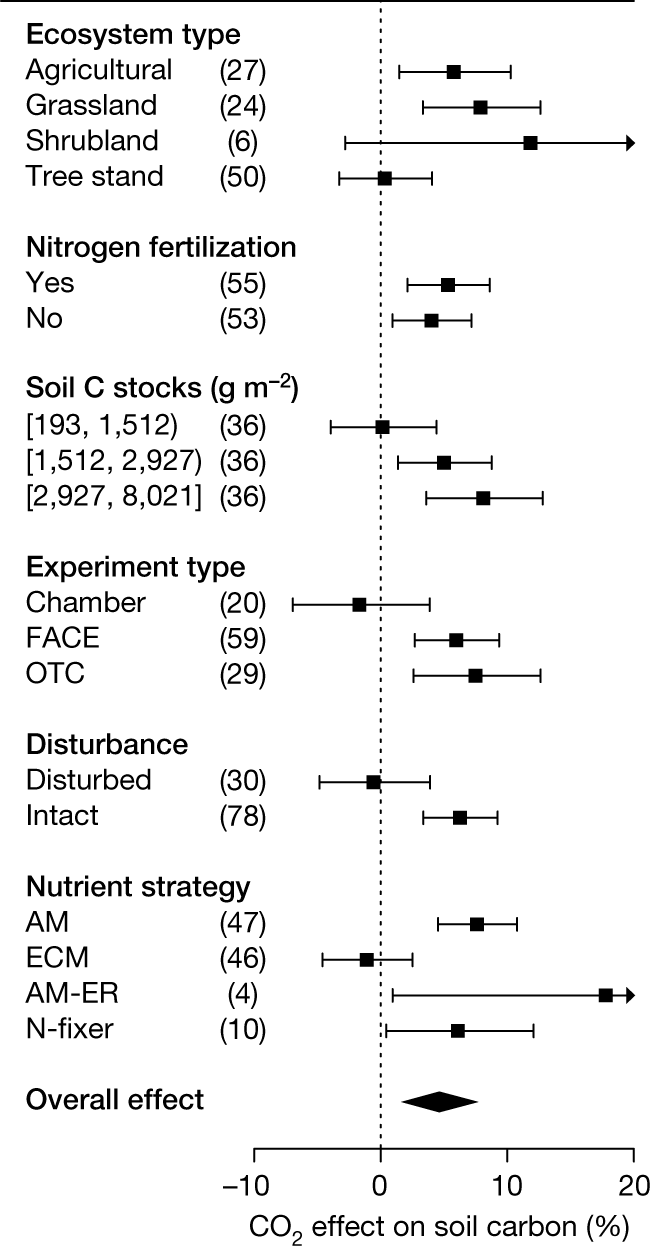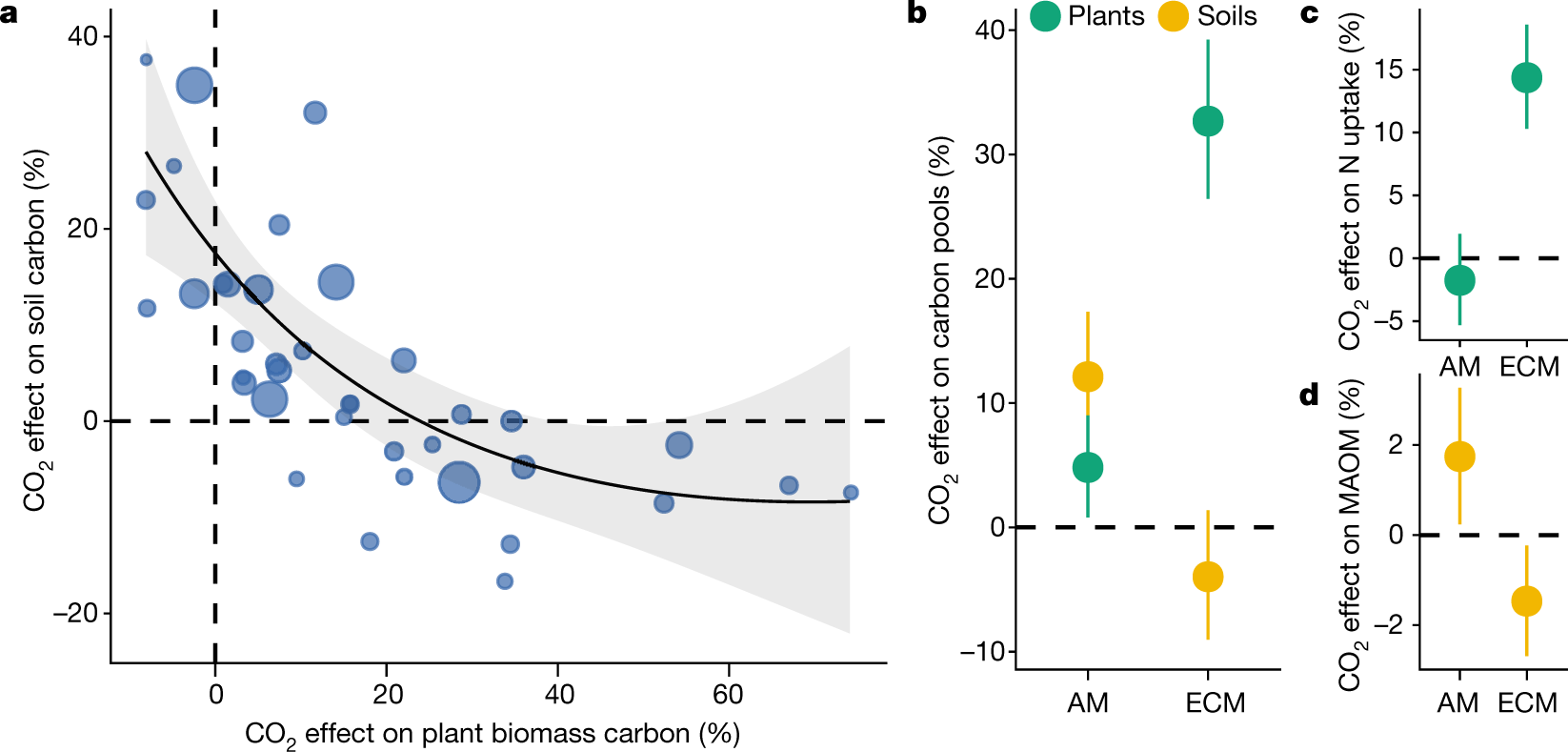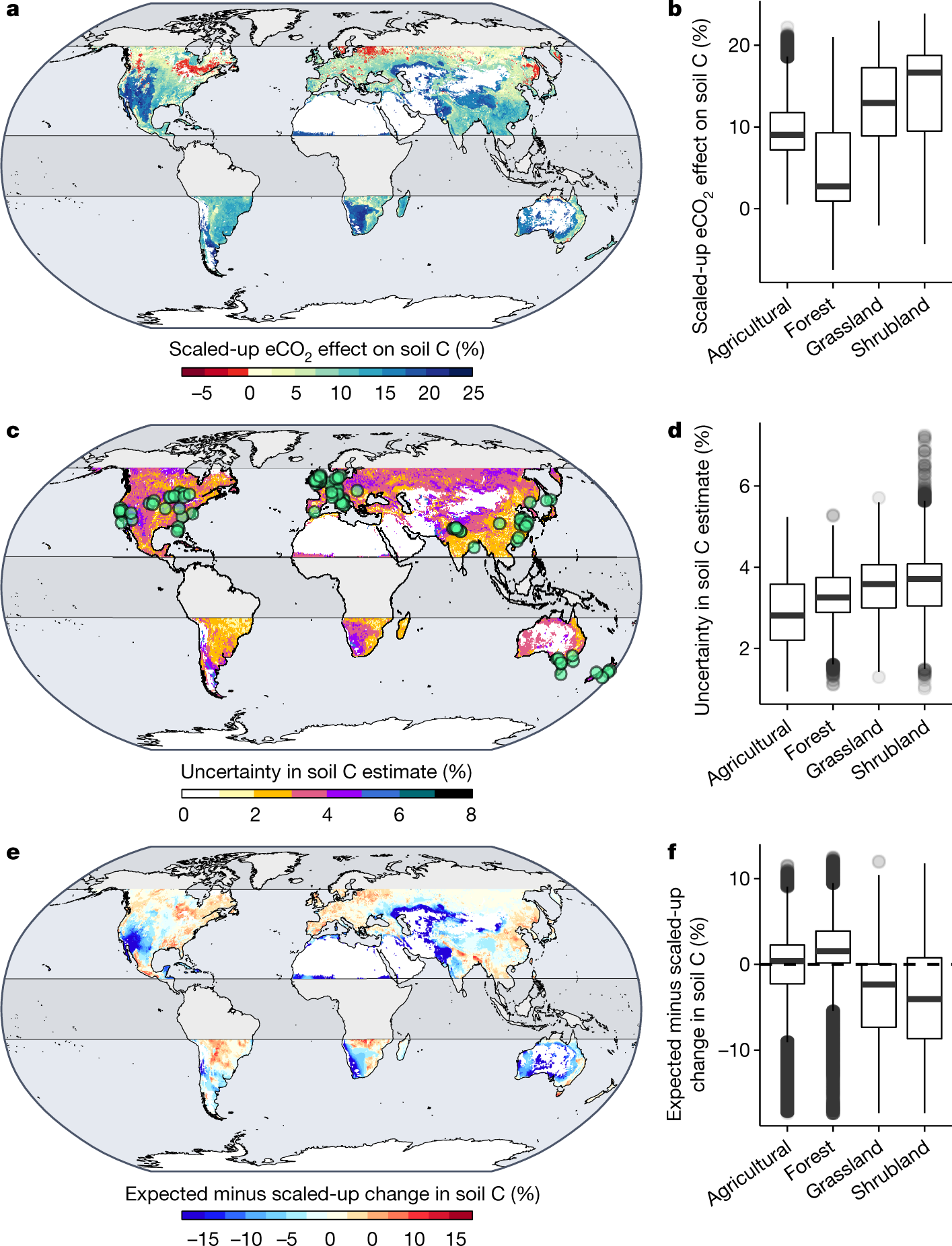Science
Related: About this forumA trade-off between plant and soil carbon storage under elevated CO2
The paper I'll discuss in this post is this one: Terrer, C., Phillips, R.P., Hungate, B.A. et al. A trade-off between plant and soil carbon storage under elevated CO2. Nature 591, 599–603 (2021).
The abstract is open sourced, but it is useful to excerpt here to get some abbreviations understood:
It currently seems likely to me that this Sunday, a new weekly average record for concentrations of the dangerous fossil fuel waste carbon dioxide will be set at the Mauna Loa CO2 observatory, probably near, at, or above 418 ppm. (The previous all time record was established in the week beginning February 28 of this year, 417.97 ppm.)
Last year, for the week beginning March 22, 2020, the weekly average reading at Mauna Loa was 415.52. The high for the year, which established a new record until this year, was 417.43, 1.89 ppm higher, observed for the week beginning May 24, 2020. All this suggests that we may see a weekly average reading of close to 420 ppm this year, possibly above it.
We are doing nothing to address climate change. Nothing beyond reciting the usual myths on our side of the political spectrum (so called "renewable energy" will save us) or simply engaging in lying and denial on the right ("climate change is not happening" or " it is not driven by human actions" or "it can be addressed by 'market' solutions."
We may think if we plant a lot of trees, we can ameliorate the problem, but the fact is that we are destroying forests and other wildernesses at an alarming rate, and many pristine areas are now being rendered into industrial parks for land intensive and material intensive "renewable energy," which has not worked to address climate change, is not working to address climate change, and will not work to address climate change. But even if we were not engaged in these massive efforts to destroy forests, it appears, if this paper is correct, that improvements in the mass of biomass on the surface will be offset by decreased soil carbon storage.
From the introduction to the paper:
Plant growth generally increases in response to eCO24,12, with soil nutrients identified as the dominant factor explaining variability across experiments12,13,14,15. The effect of eCO2 on SOC stocks (?soil) is more equivocal. Although the expectation is that SOC will accrue as eCO2 increases plant growth16, a few experiments show increases in ?soil, many show no change, and some even show losses7. The observed variation in ?soil across experiments is puzzling, and there is wide disagreement regarding the dominant mechanisms explaining this variation7,17,18.
A positive relationship between the effects of eCO2 on plant biomass and SOC pools is expected if increased plant production under eCO2 increases carbon inputs (litter) into the soil. Indeed, a positive relationship between inputs and SOC storage is formalized in first-order kinetics16 and is applied in most terrestrial ecosystem models19,20. Because the effect of eCO2 on plant aboveground biomass (?plant) is strongly correlated with the effect of eCO2 on litter production (Extended Data Fig. 1a, r = 0.81) and on root production21, a positive relationship between ?plant and ?soil can thus be expected from first-order kinetics. This hypothesis, however, ignores SOC losses associated with accelerated soil organic matter decomposition sometimes observed under eCO27,18. Plants acquire limiting resources from soils through carbon investment belowground in root growth, exudates and symbiotic bacteria and fungi. Accelerated decomposition of soil organic matter fuelled by plant carbon inputs can enable plant nutrient uptake (the “priming effect”22). The return on this belowground carbon investment is an increase in aboveground biomass production15. However, the priming effect can decrease SOC5. A negative relationship between ?plant and ?soil may thus emerge through the economics of plant resource acquisition.
Here, we evaluate the mechanisms of ?soil, including its relationship with ?plant, by synthesizing 268 observations of ?soil from 108 eCO2 experiments spanning the globe with coupled ?plant??soil data (Supplementary Table 1) using meta-analysis techniques...
Some graphics from the paper:
Fig. 1: Meta-analysis of the effect of eCO2 on percentage SOC across different factors.

The caption:
The authors state that overall, higher CO2 levels result, according to their meta analysis, in higher soil organic carbon (SOC).
However SOC is negatively correlated with surface biomass:
Fig. 2: Elevated CO2 experiments show an inverse relationship between the effects of eCO2 on plant biomass and SOC stocks due to plant nutrient-acquisition.

The caption:
Fig. 3: Effect of eCO2 (about 240 ppm) on SOC stocks scaled up from 108 CO2 experiments.

The caption:
Fig. 4: Comparison of modelled and measured relationships between aboveground biomass and SOC responses to CO2.

The caption:
Some conclusions from the paper:
This all suggests that forests have a limited capacity to address ever increasing carbon dioxide concentrations. The authors suggest that in terms of soil carbon, grasslands are more efficient than forests.
I note that it took many millions of years for the carbon we've released in the last century to be sequestered by photosynthesis and decay. This should be a sobering thought, given our propensity to believe sunlight alone can save the world. It won't be a sobering thought, but it should be.
Have a nice day tomorrow.
Backseat Driver
(4,400 posts)Here's another article from 2 years ago that should make our heads spin in terror? hope?: How to proceed...
https://www.theatlantic.com/magazine/archive/2018/03/charles-mann-can-planet-earth-feed-10-billion-people/550928/
(Yes, quite a graphic!)
Can Planet Earth Feed 10 Billion People?
Humanity has 30 years to find out.
Story by Charles C. Mann
MARCH 2018 ISSUE - THE ATLANTIC
(This article is long, as long as NNadir's offering, and just as puzzling to pick a good path through, but read it through for another prospective of likely effects on the limits of resources on our planet Earth in the time of climate change.)
==================================================================================
OK - go: All parents remember the moment when they first held their children—the tiny crumpled face, an entire new person, emerging from the hospital blanket. I extended my hands and took my daughter in my arms. I was so overwhelmed that I could hardly think.
Afterward I wandered outside so that mother and child could rest. It was three in the morning, late February in New England. There was ice on the sidewalk and a cold drizzle in the air. As I stepped from the curb, a thought popped into my head: When my daughter is my age, almost 10 billion people will be walking the Earth. I stopped midstride. I thought, How is that going to work?
[snip] all but the last paragraph...
My daughter is 19 now, a sophomore in college. In 2050, she will be middle-aged. It will be up to her generation to set up the institutions, laws, and customs that will provide for basic human needs in the world of 10 billion. Every generation decides the future, but the choices made by my children’s generation will resonate for as long as demographers can foresee. Wizard or Prophet? The choice will be less about what this generation thinks is feasible than what it thinks is good.